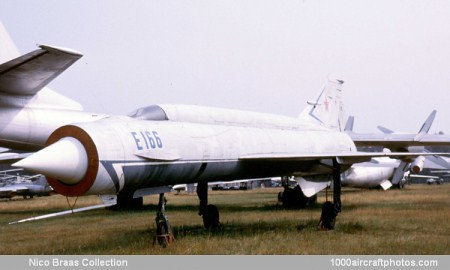08/31/2012. The Ye-152M replaced the Ye-152 as the definitive version of the experimental interceptor family, intended to carry Smerch radar and Bisnovat K-80 missiles. It also differed in other important respects from the previous Ye-152A, Ye-152/1 and Ye-152/2 prototypes. The engine was the Tumanskii R-15B-300, with maximum dry and afterburning ratings of l6,534 lb (7,500 kg) and 22,509 lb (10,210 kg). This was fitted with an improved variable nozzle, and the surrounding ejector was removed.
Along the top of the fuselage was a large spine, which in addition to the tail control rods housed three additional fuel tanks housing (from cockpit to fin), a total of 465 gal (1,760 l). As in the MiG-21, addition of this spine did not interfere with the area-ruling. On the forward fuselage were to be canard foreplanes of 11 ft 5.75 in (3.5 m) span, with a root chord of 6 ft 1.75 in (1.872 m) and a sharp-edged trapezoidal section, carrying anti-flutter rods projecting ahead at midspan. These were to be fully powered, and were tested on a slightly smaller scale on the Ye-6T-3 (one of the MiG-21F prototypes). The dorsal fin was enlarged, with a long tubular fairing at the leading edge kink.
As a stepping-stone to the Ye-152M the Ye-152/2 was rebuilt as the
Ye-152P. This was an experimental interceptor with almost all the airframe modifications intended for the Ye-152M, apart from the foreplanes where only the fixed root mountings were fitted (at a remarkable positive incidence). In the nose cone was ballast, and on the wing tips were launch shoes for ballistically correct dummy K-80 missiles. A new upwards-hinged canopy was installed, with a clear front with no optically flat wind screen and with a metal rear section mating with the spine. The only other modification was to add a small fence underneath each wing at the flap/aileron junction. Data indicate provision for a PB-1500 supersonic drop tank, but the Ye-152P is not known to have flown with this.
Tunnel testing indicated that when carrying the large delta-winged K-80 missile the torsional stiffness of the wing might prove inadequate. It was shown that at high indicated airspeeds the missiles could flutter, resulting in the initial launch trajectory being unpredictable. The OKB sought solutions in totally different geometry, including carrying the missiles well below the tip on a deep pylon and with the wing tips extended upwards at 63° in the form of a winglet. For aerodynamic and structural reasons this idea was abandoned.
No dates have been found for the Ye-152P. All that is known is that it was painted white, and that at high indicated airspeeds the missiles did flutter. By 1963 the IA-PVO had ordered the much larger Tu-128 into production as its heavy interceptor, armed with various types of R-4, the production missile derived from the K-80. Meanwhile, the MiG OKB had begun work on the much more promising Ye-155 twin-engined interceptor.
The MiG single-engined 'heavy interceptors' thus became redundant. The
Ye-152P was modified as the Ye-152M by removing the missile launchers. Later it was fitted with extended horizontal wing tips to give a wing plan similar in shape to the Ye-150, Ye-152A and MiG-21. It never flew with these extensions. Instead, in 1967 it was painted in a red/white display scheme, Ye-166 (E-166 in Cyrillic) was painted on it, and it was adorned with three small red stars and details of the records set by the Ye-152/1. It was then exhibited at Domodedovo airport as the record-breaker. For the past 45 years the Ye-152P has been stored at the museum at Monino.
